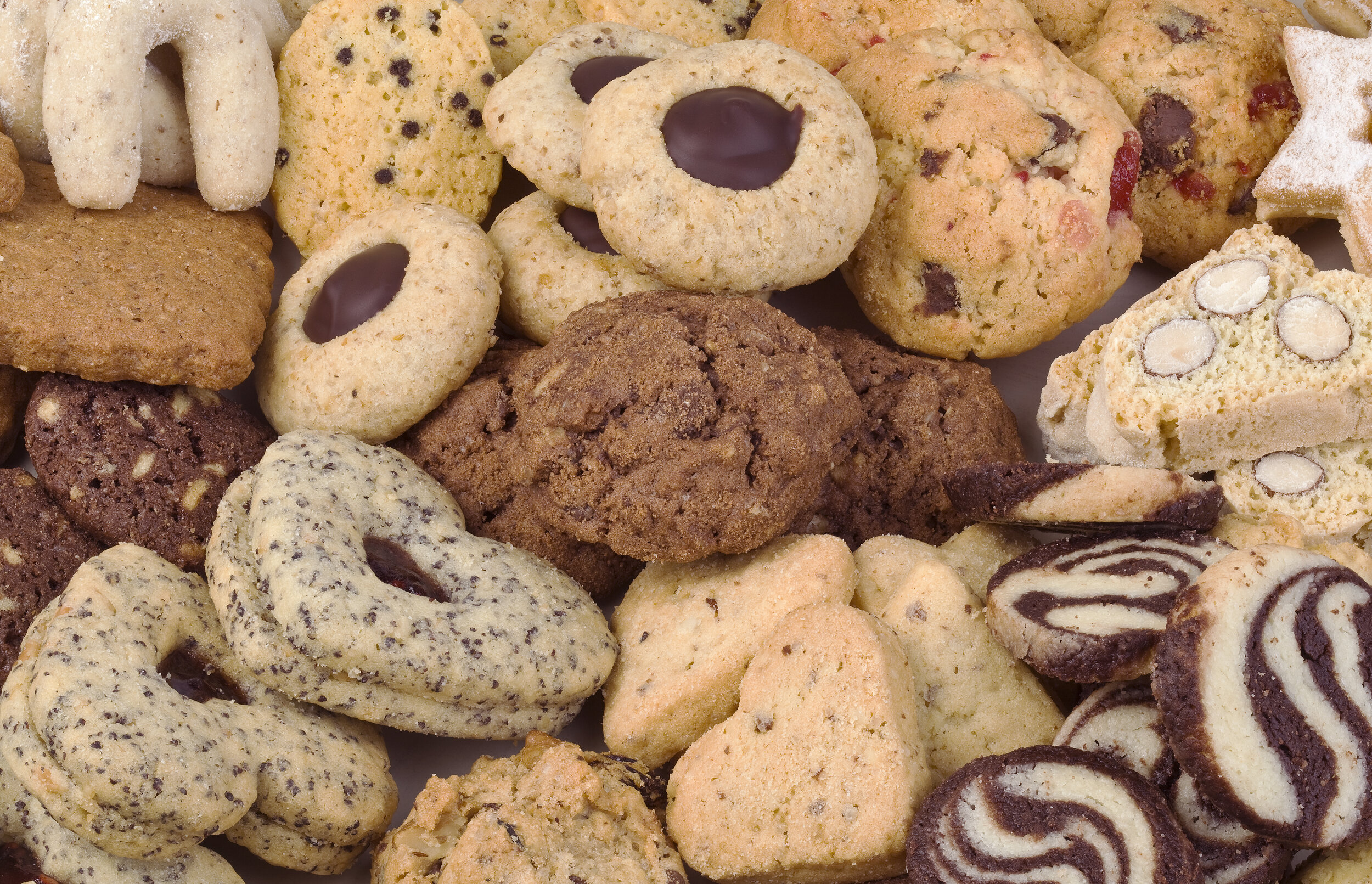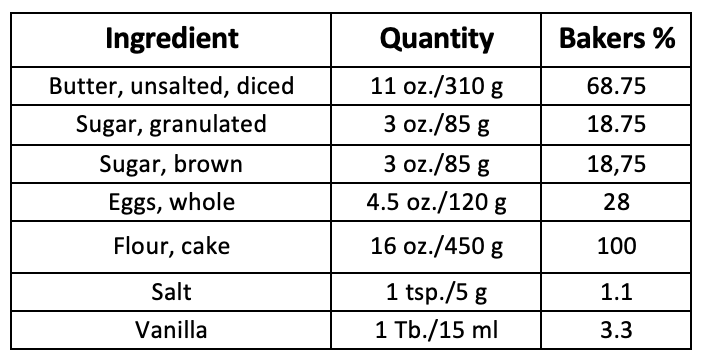Cookies
Creating Cookie Doughs
Cookie doughs are made with basic ingredients including sugar, fat, flour, eggs, and other leavening agents including baking powder or baking soda. When making cookies, it’s helpful to know how these ingredients affect the characteristics of a cookie.
Assorted Butter Cookies
Fats add flavor and often include butter, margarine, or shortening. Vegetable oils, including olive oil or walnut oil, may be used for a specific flavor profile. Fats control texture so adding more will make the cookie chewy, and less fat will make it crunchy. Fat substitutes, including nut butters, fruit purees (apple sauce, banana, pumpkin), and dairy products including yogurt and sour cream, are used in some recipes for variety in flavor, texture, or to reduce overall fat content. Eggs are used as a leavening and binding agent, add moisture, and control the spread and rise of a cookie. Egg whites produce a crisp texture, while egg yolks result in chewier textures. Sweeteners provide taste and help to tenderize the dough. Because sugar melts while it is baking, it increases the spread of the cookie. Coarse sugars spread more than confectioners’ sugar which contain cornstarch. White sugar produces a crisper cookie, while brown sugar produces a moist and chewier cookie. Molasses, honey, and maple syrup are other sweeteners that are used in cookie doughs
Flour is a binding agent that provides structure and determines the density of the cookie. The type of flour affects the overall texture of the cookie too. All-purpose flour is often used because of its versatility, bread flour adds more chew, and cake flours produce a softer texture, paler color, and less spread. Unbleached flour provides more structure than bleached versions. Whole wheat flour adds heartier and a nuttier flavor, but creates a denser texture with less chew and should be limited to about 30% of the total flour in the recipe. Gluten-free flours are sometimes substituted for wheat flour. Leavening agents including baking powder and baking soda are used to produce a lighter, cake-like texture, but are often used to encourage browning during the baking process. Salt is a flavor enhancer and also strengthens the protein in the dough making it chewier.
Add-Ins and Variations
Cookie Ratios
Cookie ratios vary depending on the desired texture. A basic cookie dough follows a 1-2-3 proportion of sugar, fat, and flour. This is a dense cookie, mildly sweet, that is prepared as an icebox dough. For a chewy texture use equal parts fat, sugar, and flour, and for a crisp cookie add more sugar.
Cookie Dough Makeup
Cookies are divided into categories based on their mixing and makeup method. The one-stage blending method combines all ingredients and gently mixes them at a low speed to a uniform batter. The creaming method combines the fat and sugar and blends them together first before adding eggs, liquids, flour, and leavening agents. The sponge method is similar to a cake batter in which the eggs and sugar are foamed before the additional of other ingredients.
Almond Biscotti
Drop cookies are scooped or spooned onto sheet pans and often use the creaming method to build volume in the cookie. Rolled, icebox, and molded cookies are made from chilled doughs that tend to be stiffer with higher flour content to minimize the spread during the baking process. Rolled varieties include sugar and gingerbread cookies that are rolled out like pastry dough and cut into desired shapes. Icebox cookie dough is shaped into a cylinder, wrapped in parchment or plastic wrap, and chilled before slicing and baking. Molded cookies may be shaped by hand or pressed into a mold. Piped cookies, like a spritz cookie, are made from soft doughs that are portioned onto a sheet pan or into a mold. Softer doughs, like a tuile, may also be prepared by using a stencil to spread the dough. Twice-baked cookies, including Italian biscotti, German zwieback, and the European Jewish Mandelbrot, are doughs formed into logs, baked, cooled, and sliced, before baking again. They are drier cookies that are ideal as an accompaniment for dunking in hot drinks.
Baking Cookies
Chilling cookie dough before baking helps to firm the fats and reduces spread. Cookie doughs that are baked fresh tend to have a doughy texture and less caramelization. Aging doughs from 12-36 hours hydrates the flour, breaks down carbohydrates into simple sugars, resulting in a sweeter tasting cookie with better caramelization and texture. Higher fat cookie doughs spread more and need about 2”/5 cm spacing, while cookies with higher flour spread minimally. Cookies baked at lower temperatures are thinner with more spread and a crisper texture., while baking at higher temperatures produces a thicker and softer cookie. The general temperature for baking cookies is 350°F/175°C on the middle rack of the oven.
Basic Cookie
This is a shortbread style cookie that can be modified with the addition of nuts, chocolate or cocoa powder, spices, and herbs. The butter can be replaced with shortening, sugar can be replaced with honey or molasses, and baking powder can be added to lighten the cookie.
Method
Step 1
Combine the butter, salt, vanilla, and white and brown sugar in a mixer fitted with a paddle
Cream the mixture until it is light and fluffy
Add one egg at a time blending thoroughly after each addition
Step 2
With the mixer on low speed, fold in one-third of the flour into the batter
Continue to mix the remaining flour in two more additions
Add any garnishes or add-in to the dough
Roll the dough into a parchment paper cylinder and chill or freeze
Step 3
Line a sheet pan with parchment paper
Slice the dough into ¼ “/1 cm slices and position 1”/3 cm apart on the pan
Bake the cookies at 350°C/175°C for 10-15 minutes until done
Cool and store in an airtight container







